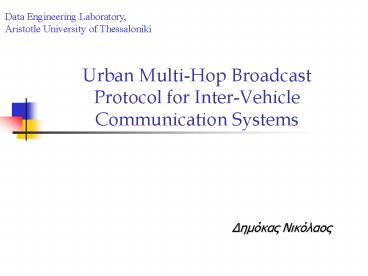Urban Multi-Hop Broadcast Protocol for Inter-Vehicle Communication Systems - PowerPoint PPT Presentation
Title:
Urban Multi-Hop Broadcast Protocol for Inter-Vehicle Communication Systems
Description:
Data Engineering Laboratory, Aristotle University of Thessaloniki Urban Multi-Hop Broadcast Protocol for Inter-Vehicle Communication Systems ... – PowerPoint PPT presentation
Number of Views:77
Avg rating:3.0/5.0
Title: Urban Multi-Hop Broadcast Protocol for Inter-Vehicle Communication Systems
1
Urban Multi-Hop Broadcast Protocol for
Inter-Vehicle Communication Systems
Data Engineering Laboratory, Aristotle
University of Thessaloniki
- ??µ??a? ?????a??
2
VANET
- Key features
- Mobility rate is high
- Movement direction and speeds are predictable
- Vehicle enter and leave the network frequently
- Broadcast is a frequently used method
- VANET applications relying on broadcast
- Traffic, Accident warnings
- Weather (warning packets generated when the road
is slippery) - Delivery of advertisements and announcements from
hotels, restaurants etc
3
Broadcast
- Disadvantages of multi-hop broadcast
- Packet collisions, hidden nodes, interference
- It is difficult to disseminate the packets to
different road segments due to tall buildings
around intersections - IEEE 802.11
- RTS/CTS handshake and acknowledgement mechanisms
decreases the hidden terminal problem and makes
the protocol reliable - May cause packet storms around the source
- UMB is designed to address
- Broadcast storm
- Hidden node
- Reliability problems
4
UMB
- Key Idea
- Directional broadcast. Sender node try to select
the furthest node in the broadcast direction to
assign the duty of forwarding without any apriori
topology information - Intersection broadcast. Repeaters at the
intersections, forward the packet to all road
segments. - Assumption
- Each node knows the location of itself,
intersections and repeaters - Goals
- Avoiding collisions due to hidden nodes.
- Using the channel efficiently
- Making the broadcast communication as reliable as
possible - Disseminating messages in all directions at an
intersection
5
Directional Broadcast (1/3)
- Divide the road portion inside the transmission
range into segments - If there is more than one node in the furthest
segment, then it is divided - If segment based iterations are not sufficient to
pick only one node, then they enter to a random
phase - UMB uses RTB and CTB
- An RTB packet includes source node position and
broadcast direction - A node receiving RTB packet
- Compute the distance to source node
- Based on the distance, it sends a channel jamming
signal, called black-burst - Sends its black-burst in the shortest possible
time - Listens to the channel. If it is empty, then its
black-burst was the longest and replies with CTB
after CTBTIME.
6
Directional Broadcast (2/3)
- Receivers send black-burst signals proportional
to their distance to the source - When there are more than one vehicle in the
furthest non empty segment - They all find the channel empty and continue to
send CTB packets - Source node detects the collisions and repeat RTB
7
Directional Broadcast (3/3)
- The furthest segment is divided into Nmax
sub-segments - Only nodes that sent the longest black-burst in
the previous iteration can join to the current
iteration - Random collision resolution phase after the Dmax
iteration - Source node goes back to the first segment
iteration after a random amount of time
8
Intersection Broadcast (1/2)
- If the forward node is inside the transmission
range of a repeater, the node sends the packet to
the repeater using point-to-point IEEE802.11 - Packet Loops
- All cars in the network record
- the packet IDs when they hear packets
- Repeaters record the packet IDs
9
Intersection Broadcast (2/2)
- RTB/CTB/DATA/ACK handshake is repeated several
times in intersections - Disadvantage
- Waste bandwidth
- Degrade the overall performance of the network,
since packets from all directions will wait the
for the repeater to be idle - Solution
- Repeaters do not repeat the information in the
DATA packet if the forward node has already
received the message































